News Flash(s)
Whio in the Manawatu Gorge Local kayaker Harley Betts recently spotted a lone WHIO in the river below the Manawatu Gorge (yes - that is the road between Manawatu and Hawkes Bay) in the vicinity of the large slip (yes the one that closed the road!) Where has it come from and where is it going to? Maybe another lone bird heading for the Tararuas?
WHIO AT CENTRE CREEK POHANGINA
Hunters recently spotted a pair of whio near Centre Creek - well down the Pohangina River and getting closer to the park Boundary. I am not aware of a sighting that far down the river for many years now.
A24s DAMAGED BY POSSUMS
Slightly old news now as this one made it to TV3. Clever possums have worked out how to get the new "chirp" caps off the A24's to get to the lure! Read more in Anthony Behrens project update.
SKINK SIGHTINGS OVER SUMMER
Peter Bird (DOC) and some hunters have reported seeing skinks over the summer - maybe the very hot weather brought them out more. Read on to see more from Pete.
Hunters recently spotted a pair of whio near Centre Creek - well down the Pohangina River and getting closer to the park Boundary. I am not aware of a sighting that far down the river for many years now.
A24s DAMAGED BY POSSUMS
Slightly old news now as this one made it to TV3. Clever possums have worked out how to get the new "chirp" caps off the A24's to get to the lure! Read more in Anthony Behrens project update.
SKINK SIGHTINGS OVER SUMMER
Peter Bird (DOC) and some hunters have reported seeing skinks over the summer - maybe the very hot weather brought them out more. Read on to see more from Pete.
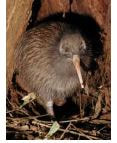
Kiwi confirmed at Maropea forks hut Trampers Carl Knight and Mike Parr, camping near the hut at Maropea Forks recently confirmed the presence of kiwi. “based upon sound and proximity of sounds (plural) that the male kiwi calls and scuffling/grazing sounds, I think got within three of meters of my bivi site.”
Dates for next whio collective hui August 20-21 River Valley Lodge - to those who regularly attend or if you are interested mark this in your diary.
NEWS FROM DOC
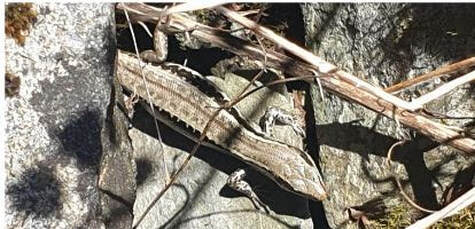
RUAHINE REPTILES
While working in the Northern Ruahines in February controlling old man’s beard, I stumbled across two populations of Small-scaled skinks (Oligosoma microlepis) - pictured below. This was a good find in that there were no records of the species in this particular area.
DOC is interested in any skink or gecko sightings, especially in the Ruahine Forest park. If you could send me the location, date, and good clear full body photos from the top, including any lateral markings, scale patterns on top of the head and if possible, any photos of the belly to the email below, it would be much appreciated. This information gives us more of a picture on species distribution in regard to both native and introduced lizard species
While working in the Northern Ruahines in February controlling old man’s beard, I stumbled across two populations of Small-scaled skinks (Oligosoma microlepis) - pictured below. This was a good find in that there were no records of the species in this particular area.
DOC is interested in any skink or gecko sightings, especially in the Ruahine Forest park. If you could send me the location, date, and good clear full body photos from the top, including any lateral markings, scale patterns on top of the head and if possible, any photos of the belly to the email below, it would be much appreciated. This information gives us more of a picture on species distribution in regard to both native and introduced lizard species

Introduced Australian plague skinks are common around the Palmerston North area and can be differentiated from native skink species by the scale patterns on their heads.
Pete Bird
Department of Conservation
Palmerston North Office
pbird@doc.govt.nz 06 350 9700
Pete Bird
Department of Conservation
Palmerston North Office
pbird@doc.govt.nz 06 350 9700
NORTHERN RUAHINE WHIO SURVEY
A survey was undertaken in the Northern Ruahine Forest Park, in fine weather between the 18th and 20th February 2022 by James McLauchlin (McLauchlin Ecological Services and Consultants), Tim Quinnell (DOC), Pete Bird (DOC) and two certified whio dogs. The trip had been delayed due to flooding and bad weather. A number of feather samples were collected for DNA analysis over the survey as some birds had started to moult.
A survey was undertaken in the Northern Ruahine Forest Park, in fine weather between the 18th and 20th February 2022 by James McLauchlin (McLauchlin Ecological Services and Consultants), Tim Quinnell (DOC), Pete Bird (DOC) and two certified whio dogs. The trip had been delayed due to flooding and bad weather. A number of feather samples were collected for DNA analysis over the survey as some birds had started to moult.
The area surveyed was included in a 32,000 ha area treated with aerially applied 1080 baits in both 2017 and 2019 under both the Battle For Our Birds and Tiakina Nga Manu banners and is also included in a volunteer trapping programme targeting mustelids using DOC 200 series single action kill traps and goodnature A24 self-setting traps.
Waikatore Stream
The Waiokotore survey started 350 metres upstream of the old Waiokotore Bivvy site and continued downstream to the Waiokotore Stream/Mangatera River confluence. The survey this year was undertaken further upstream than the 2021 survey. A total of ten birds were found on this stretch of water consisting of two pairs, one adult female, two unknown adults and three juveniles. A number of birds observed had started to moult. It is possible that an extra pair was missed on the Waiokotore stream as the dogs indicated but the terrain made it impossible to access the area.
Mangatera River
The Mangatera survey started 250 metres downstream of the Mangatera River/Waiokotore Stream confluence and finished 720 metres upstream of the Mangatera River/Potae Stream Confluence. 680 metres of the Potae Stream was also surveyed. Within this stretch of the Mangatera, there is a 290 metre section of the river that was not surveyed due to the terrain, the river is gorgy and at time runs underground. The survey area was also extended 150 metres upstream than in previous years, but very little sign was found within this 150 metres, and no birds were observed. A total of seven birds were found on this stretch of water consisting of two pairs, one adult female and two juveniles. No birds were observed in the Potae Stream this year, but a small amount of sign was found.
The Mangatera survey started 250 metres downstream of the Mangatera River/Waiokotore Stream confluence and finished 720 metres upstream of the Mangatera River/Potae Stream Confluence. 680 metres of the Potae Stream was also surveyed. Within this stretch of the Mangatera, there is a 290 metre section of the river that was not surveyed due to the terrain, the river is gorgy and at time runs underground. The survey area was also extended 150 metres upstream than in previous years, but very little sign was found within this 150 metres, and no birds were observed. A total of seven birds were found on this stretch of water consisting of two pairs, one adult female and two juveniles. No birds were observed in the Potae Stream this year, but a small amount of sign was found.
Remutupo Stream
The Remutupo was surveyed from its confluence with the Mangatera River, upstream for 7.1 kilometres. 650 metres of an unnamed side creek near the old Remutupo hut site, which was surveyed last year, was also surveyed this year. A total of twenty-three birds were found on this stretch of water consisting of six pairs, three adult males, one unknown adult and seven juveniles. One pair was found 650 metres up the unnamed side creek
The Remutupo was surveyed from its confluence with the Mangatera River, upstream for 7.1 kilometres. 650 metres of an unnamed side creek near the old Remutupo hut site, which was surveyed last year, was also surveyed this year. A total of twenty-three birds were found on this stretch of water consisting of six pairs, three adult males, one unknown adult and seven juveniles. One pair was found 650 metres up the unnamed side creek
MANAAKI RUAHINE MAKARETU VALLEY
RESTORATION PROJECT - Anthony Behrens
It's been an interesting few months for the Manaaki Ruahine Mākāretu Valley Restoration Project.
We've been doing a lot less trapping as we develop the next stage of the project. We're also preparing the existing line of 50 traps that run from the Kashmir Road carpark to downstream from Awatere Hut for regular shift "rosters" that will be put out on a new Facebook group. Watch this space and the original Manaaki Ruahine Facebook page for details.
RESTORATION PROJECT - Anthony Behrens
It's been an interesting few months for the Manaaki Ruahine Mākāretu Valley Restoration Project.
We've been doing a lot less trapping as we develop the next stage of the project. We're also preparing the existing line of 50 traps that run from the Kashmir Road carpark to downstream from Awatere Hut for regular shift "rosters" that will be put out on a new Facebook group. Watch this space and the original Manaaki Ruahine Facebook page for details.

A "highlight" of the last few months was the catching of 5 stoats on our 30 trap Wānanga line in one month - using pig fat. It's cheaper than erayze, is longer lasting AND is obviously very popular. A lowlight was the vandalising of the new A24s that Horizons funded last year. 11 of 15 traps that we put out on the Apiti Track had their Bluetooth Chirps and blood flavoured ALPS stolen by clever and determined possums. It was probably a little embarrassing for GoodNature having this splashed all over TV, but they've have come to the party - with Darren Peters paying us a visit with some replacement parts and some of his usual good and entertaining advice.
We have replaced the new-fangled Chirps with old fashioned digital counters and the original A24 tops. We reckon the high-tech stuff is good for urbanites, but a bit delicate and fiddly for the Ruahine
We've also taken possession of 40 double set DOC 200 and DOC 150 traps. They will form the basis of a new community trapping project around the source of the Manawatū RIver. We have been approached by a local farmer who is interested in managing it with us. Again...keep
an eye on our Facebook page for announcements regarding this exciting development. We hope to have the traps ready for placement by spring...possibly before.
We've also taken possession of 40 double set DOC 200 and DOC 150 traps. They will form the basis of a new community trapping project around the source of the Manawatū RIver. We have been approached by a local farmer who is interested in managing it with us. Again...keep
an eye on our Facebook page for announcements regarding this exciting development. We hope to have the traps ready for placement by spring...possibly before.

We also installed three of our new Autotrap AT220s in the area - we're confident that there are a few less possums in behind Norsewood now, but have yet to go in and have a look. We are also putting the call out for unwanted A12s. We already have seven and would like more - to protect their little cousins and to make our trips into the Apiti Track more productive. So...if you have an unproductive A12 sitting in your back paddock...let us know. We'll put it to good use. Give Anthony a bell on 027 470 9829
OROUA/POHANGINA PROJECT UPDATE
Longview Update from Ben Douglas
Longview Update from Ben Douglas

Trap catches on the Longview / Upper Pohangina trapline have been very low. A summary of catches to date is shown in the table below. Important to note that these are organised by calendar year, I’ll convert to the 1 July to 30 June year at some point soon, and that will give a more useful pattern. Many thanks to Liz Nicholson and Dave Bashford (pictured) from the Wairarapa who have carried out the majority of the rebaits for some time now. Thank you also to Karen McNicol for her help.
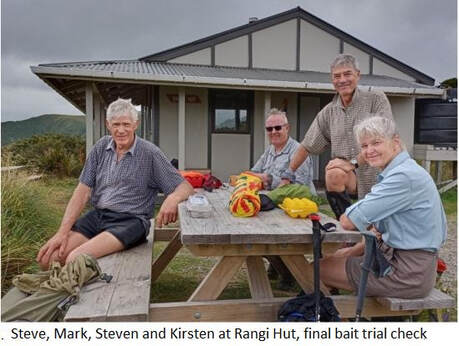
Oroua Valley and the Rangi Loop - Janet
WHAT A BUSY SUMMER! Thanks as always to the great team of volunteers who continue to help with the Oroua trap lines. There have been regular checks to all the traps and catch numbers have remained very low.
Over the summer a large part of the work was helping with a bait trial for Landcare scientist Patrick Garvey. This involved the Rangi Loop trap line (looked after by Steve Bielski) and 100 traps in the Oroua including most of the Tunupo line and the traps to Tunupo stream. The work involved 2 trap checks per month check so over the 3 months of the trail there were 7 visits to the traps. This meant quite a bit more work - there was a great turn out from a group of regulars which certainly helped a lot. Steve and I really appreciated the support . Now that we are back to once a month the work load seems a lot less!
Thanks go to Manawatu Branch NZDA members for setting out the bait trial and to the rest of the team - Michelle Benton, Kirsten Olsen, Stephen Legg, Mark Tootill, Malcolm Thomas, Joe Faisandier, Helen and Kate Thomas, Ernie and Annemarie Cook, John Beech, Katie Bealing, Hannah Russell, Cecilia Falla and Sam, Warren Wheeler, Robyn Boocock, Dave and Nikki Middleditch and Steve and Mary Bielski.
I sent the results through to Patrick - who sent the following response - I will leave it to Patrick to tell us what the results mean at some later date.
"Despite the low number of captures overall, the silicone lure did pretty well with stoats. Not sure what happened with the natural lure as result were better in the past. I may have selected towels from the wrong ferret! It should all come out in the wash as we are testing the same three lures at other sites and the collective results will be key. Anyway, your results are the first in and so far, so good."
WHAT A BUSY SUMMER! Thanks as always to the great team of volunteers who continue to help with the Oroua trap lines. There have been regular checks to all the traps and catch numbers have remained very low.
Over the summer a large part of the work was helping with a bait trial for Landcare scientist Patrick Garvey. This involved the Rangi Loop trap line (looked after by Steve Bielski) and 100 traps in the Oroua including most of the Tunupo line and the traps to Tunupo stream. The work involved 2 trap checks per month check so over the 3 months of the trail there were 7 visits to the traps. This meant quite a bit more work - there was a great turn out from a group of regulars which certainly helped a lot. Steve and I really appreciated the support . Now that we are back to once a month the work load seems a lot less!
Thanks go to Manawatu Branch NZDA members for setting out the bait trial and to the rest of the team - Michelle Benton, Kirsten Olsen, Stephen Legg, Mark Tootill, Malcolm Thomas, Joe Faisandier, Helen and Kate Thomas, Ernie and Annemarie Cook, John Beech, Katie Bealing, Hannah Russell, Cecilia Falla and Sam, Warren Wheeler, Robyn Boocock, Dave and Nikki Middleditch and Steve and Mary Bielski.
I sent the results through to Patrick - who sent the following response - I will leave it to Patrick to tell us what the results mean at some later date.
"Despite the low number of captures overall, the silicone lure did pretty well with stoats. Not sure what happened with the natural lure as result were better in the past. I may have selected towels from the wrong ferret! It should all come out in the wash as we are testing the same three lures at other sites and the collective results will be key. Anyway, your results are the first in and so far, so good."
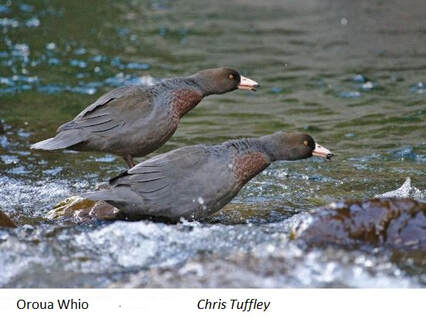
We have had a few trips in the Oroua River where there are regular whio sightings near Tunupo Stream and at Iron Gate Hut. When the flow is low the Oroua, especially the section below Tunupo Fly Camp is a magical place to be. Yvette Cottam and I camped mid way down river in January hoping to spot some more whio but I am starting to understand that January is not a good time to see the Oroua ducks - maybe they are moulting then. Later in the month we replaced some more of the aging mechanisms and spent time with the Tunupo Stream whio. Thanks to Chris Tuffley, Kirsten Olsen, Stephen Legg and Ernie Cook for helping with that job. Thanks to Gordon Groube, Ian and Josh Rasmussen and Chris Tuffley for keeping up the work on the Triangle Hut Loop.
Pohangina River
The Pohangina A24 line is always a bit of a challenge and this Heavy rains and flooding late in 2021 help up the servicing of the A24's in the Pohangina River. Chris Tuffley, Zoe Matthews and Matt Compton serviced the Top Gorge area in late November. A hunting party flew gear into Ngamoko Hut in early January which was very helpful - thanks to Ken from Bettany Gears Paraparaumu.. Chris T tramped in and serviced the traps down to Mid Pohangina and well up the river towards Leon Kinvig. Graham Peters, Michelle Benton and I lugged heavy gear over to Leon Kinvig Hut in late January. Yvette Cottam met us in there and we finished off the rest of the traps and had an extra day enjoying the area and doing some hunting. Not many whio were seen on this trip.
We plan to service all these traps again before winter sets in. It will be interesting to see if the recent big flood event has altered the river much. We are looking forward to Leon Kinvig Hut's upgrade, which should be happening in May.
The Pohangina A24 line is always a bit of a challenge and this Heavy rains and flooding late in 2021 help up the servicing of the A24's in the Pohangina River. Chris Tuffley, Zoe Matthews and Matt Compton serviced the Top Gorge area in late November. A hunting party flew gear into Ngamoko Hut in early January which was very helpful - thanks to Ken from Bettany Gears Paraparaumu.. Chris T tramped in and serviced the traps down to Mid Pohangina and well up the river towards Leon Kinvig. Graham Peters, Michelle Benton and I lugged heavy gear over to Leon Kinvig Hut in late January. Yvette Cottam met us in there and we finished off the rest of the traps and had an extra day enjoying the area and doing some hunting. Not many whio were seen on this trip.
We plan to service all these traps again before winter sets in. It will be interesting to see if the recent big flood event has altered the river much. We are looking forward to Leon Kinvig Hut's upgrade, which should be happening in May.
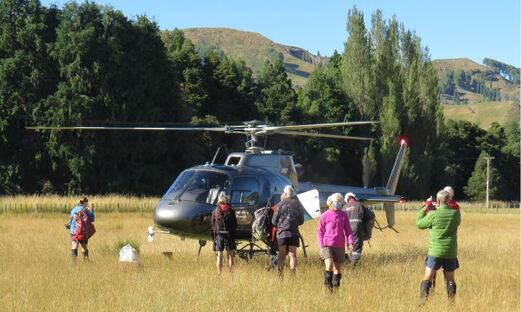
TE POTAE UPDATE- Janet
It has been a challenging season for the team who work to keep this project going in the Nth Western Ruahines. Of the seven scheduled checks this season, so far 3 out of 6 have happened. Thanks to everyone who has volunteered so far and to the DOC rangers who have coordinated the volunteer roster and other logistics.
The January check struck great weather - the team comprised members of the Palmerston North Tramping and Mountaineering Club and others. The rats catch numbers seem quite high but mustilids numbers are low. Jean Garman and I had the lucky job of servicing the Ikawatea Stream traps which means you get to see whio - we didn't see that many (as we tend to talk too much) but there was a lovely family with very small ducklings well upstream. There have been plenty of whio sightings on other trips this year - it seems to have been an excellent breeding season with good survival. Yvette Cottam photographed the family pictured below near Iron Bark Hut.
Ian Rasmusen has been deploying the acoustic recorders while out on the Te Potae checks in the Maropea Forks area - hopefully we will pick up some kiwi calls out of the many nights of data we have to analyse.
It has been a challenging season for the team who work to keep this project going in the Nth Western Ruahines. Of the seven scheduled checks this season, so far 3 out of 6 have happened. Thanks to everyone who has volunteered so far and to the DOC rangers who have coordinated the volunteer roster and other logistics.
The January check struck great weather - the team comprised members of the Palmerston North Tramping and Mountaineering Club and others. The rats catch numbers seem quite high but mustilids numbers are low. Jean Garman and I had the lucky job of servicing the Ikawatea Stream traps which means you get to see whio - we didn't see that many (as we tend to talk too much) but there was a lovely family with very small ducklings well upstream. There have been plenty of whio sightings on other trips this year - it seems to have been an excellent breeding season with good survival. Yvette Cottam photographed the family pictured below near Iron Bark Hut.
Ian Rasmusen has been deploying the acoustic recorders while out on the Te Potae checks in the Maropea Forks area - hopefully we will pick up some kiwi calls out of the many nights of data we have to analyse.
LISA WHITTLE REPORTS FROM THE EASTERN SIDE OF THE RUAHINES
Apias-Ikawatea Forks - Upper Makaroro traplines
Three trips were completed over the breeding season along Apias to Ikawatea Forks, Main Range to PioPio tarns and return, and two trips in via Sentry Box spur to service traplines for the Upper Makaroro trapline (WTMC).
Early January trip down the length of the Apias was the best. Upstream from Rockslide biv we saw only two pair of whio with 4 ducklings between them.
We were beginning to think that the whio pairs had had a chancy season due to the December rains. Below Rockslide we saw four whio pair with clutches of 4, 6, 6 and 7 class 4 (almost fledged) ducklings; a total of 41 ducks on the Apias that day. A bumper season.
Due to covid impact on tramping club membership, the WTMC have found it hard to get folk who can commit to trapline checks. We’ve picked up two trap checks, including one to service the A24 line – dropping down from point 1406 on the Main Range into the upper Makaroro stream. It was fun doing a different trapline circuit! If folk are keen to pick up any monthly trapline checks please email me, thanks! I'll coordinate monthly sign ups. whittllisa@gmail.com
Apias-Ikawatea Forks - Upper Makaroro traplines
Three trips were completed over the breeding season along Apias to Ikawatea Forks, Main Range to PioPio tarns and return, and two trips in via Sentry Box spur to service traplines for the Upper Makaroro trapline (WTMC).
Early January trip down the length of the Apias was the best. Upstream from Rockslide biv we saw only two pair of whio with 4 ducklings between them.
We were beginning to think that the whio pairs had had a chancy season due to the December rains. Below Rockslide we saw four whio pair with clutches of 4, 6, 6 and 7 class 4 (almost fledged) ducklings; a total of 41 ducks on the Apias that day. A bumper season.
Due to covid impact on tramping club membership, the WTMC have found it hard to get folk who can commit to trapline checks. We’ve picked up two trap checks, including one to service the A24 line – dropping down from point 1406 on the Main Range into the upper Makaroro stream. It was fun doing a different trapline circuit! If folk are keen to pick up any monthly trapline checks please email me, thanks! I'll coordinate monthly sign ups. whittllisa@gmail.com
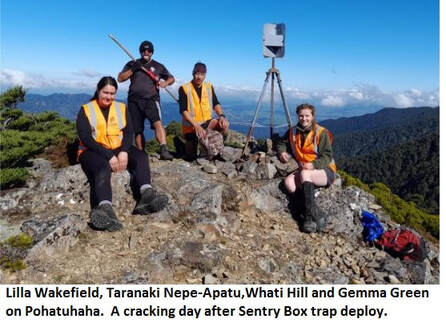
Mauri Oho JFN project
Mauri Oho are based at the old OngaOnga DOC quarters, sharing the site with the OngaOnga Historical society. Mauri Oho Project Manager is Arapera Paewai who is an experienced project leader in te taiao and a member of RWP.
Our Kaimanaaki Taiao crew are led by Operations Manager Phillip Hansen, who has tramped and hunted in the northern Ruahine for over 50 years. He claims his first wife is Ruahine, although he's happily married and has a wonderful and understanding wife. Phillip manages the Dead Dog A24 trapline (since 2015), a line that proves the effectiveness of the A24, with 2-3 pairs of whio regularly sighted and breeding on Dead Dog stream.
Mauri Oho’s main mission is trapping along the Ruahine Forest Park boundary mainly in the Kereru area, strengthening the back country network from Sunrise northwards. Mahi includes riparian restoration on specific sites, providing year-round jobs for 12 people. For more info, visit our website https://maurioho.nz/
Mauri Oho are based at the old OngaOnga DOC quarters, sharing the site with the OngaOnga Historical society. Mauri Oho Project Manager is Arapera Paewai who is an experienced project leader in te taiao and a member of RWP.
Our Kaimanaaki Taiao crew are led by Operations Manager Phillip Hansen, who has tramped and hunted in the northern Ruahine for over 50 years. He claims his first wife is Ruahine, although he's happily married and has a wonderful and understanding wife. Phillip manages the Dead Dog A24 trapline (since 2015), a line that proves the effectiveness of the A24, with 2-3 pairs of whio regularly sighted and breeding on Dead Dog stream.
Mauri Oho’s main mission is trapping along the Ruahine Forest Park boundary mainly in the Kereru area, strengthening the back country network from Sunrise northwards. Mahi includes riparian restoration on specific sites, providing year-round jobs for 12 people. For more info, visit our website https://maurioho.nz/
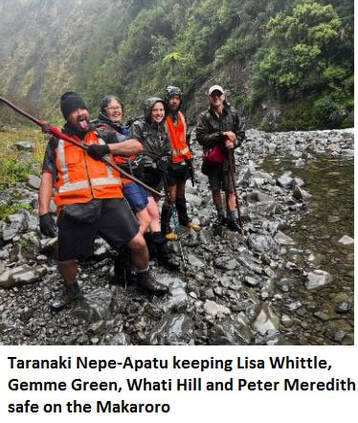
Mauri Oho mahi update
In mid-November the crew began making trap boxes at OngaOnga HQ. Over 600 of 1200 DOC200 and DOC250 traps have been made and deployed. Traplines are in place with monthly servicing checks.
Lines run from Dead Dog-Big Hill stream boundary, Herricks, Gull stream, Frying Pan Flat, Three Fingers, Golden Crown up from Masters Shelter, Tarapeke, Jumped Up Spur, Sentry Box Spur to Main Range, and further south lines up Yeomans heading north with a new line underway up to Parks Peak. Other lines deployed to Sunrise and down the length of Nomans road to the first big corner. Phew… massive productivity from our dedicated Kaimanaaki Taiao.
Trap network layout along farm boundaries is usually two DOC200s, with a DOC250 in between. A typical batch of kills are 3 ferrets, 8-10 hedgehogs. 2-3 stoats and once we caught 3 juvenile feral cats. Hedgehogs are an unexpected 'delight'! We are yet to see full hedgehog invasion!
We enjoy a monthly check with Peter Meredith on the Forest & Bird Makaroro trapline to Barlows Hut. Last check in March we saw two pair of whio and a lone juvenile male on the river. A Big shout out to Peter who's been managing this line for some years. Regular checks are paying back with a strong whio presence on the Makaroro
In mid-November the crew began making trap boxes at OngaOnga HQ. Over 600 of 1200 DOC200 and DOC250 traps have been made and deployed. Traplines are in place with monthly servicing checks.
Lines run from Dead Dog-Big Hill stream boundary, Herricks, Gull stream, Frying Pan Flat, Three Fingers, Golden Crown up from Masters Shelter, Tarapeke, Jumped Up Spur, Sentry Box Spur to Main Range, and further south lines up Yeomans heading north with a new line underway up to Parks Peak. Other lines deployed to Sunrise and down the length of Nomans road to the first big corner. Phew… massive productivity from our dedicated Kaimanaaki Taiao.
Trap network layout along farm boundaries is usually two DOC200s, with a DOC250 in between. A typical batch of kills are 3 ferrets, 8-10 hedgehogs. 2-3 stoats and once we caught 3 juvenile feral cats. Hedgehogs are an unexpected 'delight'! We are yet to see full hedgehog invasion!
We enjoy a monthly check with Peter Meredith on the Forest & Bird Makaroro trapline to Barlows Hut. Last check in March we saw two pair of whio and a lone juvenile male on the river. A Big shout out to Peter who's been managing this line for some years. Regular checks are paying back with a strong whio presence on the Makaroro






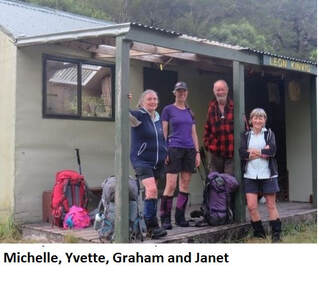



 RSS Feed
RSS Feed